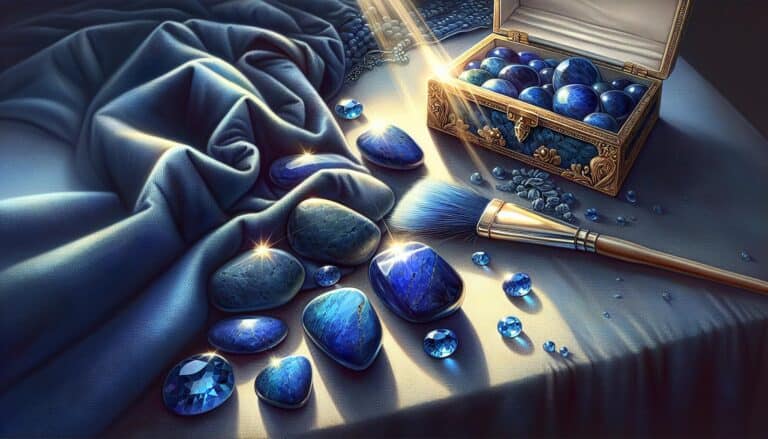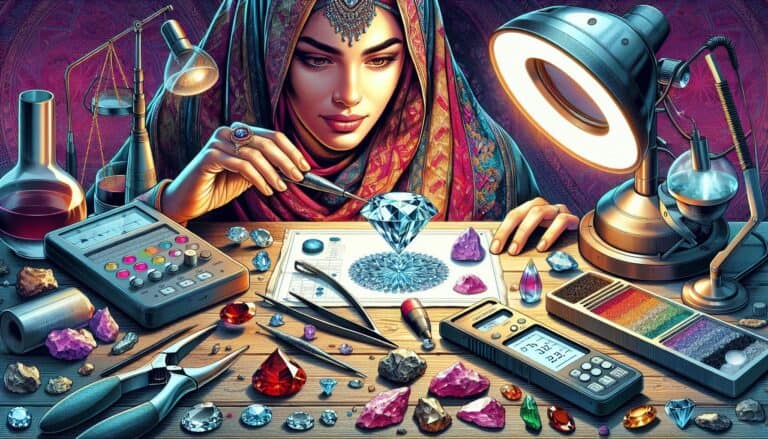Ever wondered what makes tanzanite so coveted in the gemstone market?
You’re not alone. This stunning blue-violet gem has caught the eye of collectors and jewelry enthusiasts alike. But with its beauty comes the question: how much is tanzanite worth?
The value of tanzanite can vary widely, influenced by factors like size, color, clarity, and cut. Whether you’re considering a purchase or you’ve inherited a piece, understanding its worth is key.
Let’s dive into the world of tanzanite and uncover the elements that determine its market value.
Tanzanite’s value is determined by color, clarity, cut, and carat weight. The most coveted tanzanite exhibits a deep blue-violet color, high clarity, and expert cut. Found only in Tanzania, its rarity significantly influences its worth. Market demand and limited availability also play key roles in pricing this unique, pleochroic gemstone.
What Is Tanzanite?
You may be curious about the origins of the captivating gem you’re considering adding to your collection. Tanzanite is a blue-violet variety of the mineral zoisite and is found exclusively in the Merelani Hills of Northern Tanzania, near the majestic Mount Kilimanjaro.
Discovered in 1967, tanzanite has rapidly become one of the most sought-after gemstones in the world. Due to its limited supply, tanzanite is considered a thousand times rarer than diamonds. The fact that it’s only found in a small geographic area adds to its allure and perceived value.
The gemstone’s visual appeal is undeniable. Tanzanite exhibits a unique phenomenon known as pleochroism, which means it shows different colors when viewed from different directions. This range from a deep, saturated blue, often likened to that of sapphire, to violet and even burgundy, depending on the lighting and the specific angle of view.
When you’re in the market for tanzanite, you’ll encounter a range of qualities and sizes. Larger stones tend to exhibit more pronounced hues, and consequently, are more valuable. The rarity of tanzanite, along with its rich color and the skill required to cut the stone to enhance its natural pleochroism, makes each piece a unique treasure.
Caring for your tanzanite involves protecting it from sudden temperature changes and harsh chemicals that could damage the stone. Tanzanite is also less hard than sapphires or diamonds, which means it’s more susceptible to scratches. Proper handling and storage are crucial to maintain its stunning appearance.
Understanding these elements about tanzanite not only increases your appreciation for this gemstone but also informs your investment decisions. Properties like the distinct pleochroism, the gemstone’s rarity, and the insightful care needed for maintenance are just the beginning of what makes tanzanite truly captivating.
Tanzanite Prices: Factors That Affect Value

When you’re looking into the worth of tanzanite, understanding the different factors that influence its value is key. The price of tanzanite can fluctuate based on several elements, including color, clarity, cut quality, market demand, and availability.
Color, Clarity, and Cut Quality
Color is the most significant factor in tanzanite valuation. The most sought-after tanzanite exhibits a deep, vibrant blue with hints of violet. This is often referred to as “AAA” grade and commands premium prices. The more intense and saturated the color, the higher the per-carat price you can expect to pay.
Clarity refers to the presence of inclusions within the gemstone. You’ll find that the fewer the inclusions, the more valuable the stone. Clean tanzanite with high clarity is rare and thus, more expensive. However, due to tanzanite’s crystal structure, some inclusions are common and don’t always detract significantly from its value as long as the gem’s transparency is maintained.
Cut quality greatly impacts a tanzanite’s brilliance and overall appearance. A well-cut tanzanite will display its pleochroic colors effectively and contribute to its desirability. Expert cutting can also hide or minimize the appearance of inclusions, enhancing the stone’s clarity and value.
Market Demand and Availability
Tanzanite’s market demand is relatively high considering its rarity and unique beauty. As it’s only sourced from a specific location in Tanzania, its availability is limited which tends to keep prices robust. That being said, tanzanite’s value can also be affected by the general economic climate and trends in the gemstone market.
Since tanzanite is a relatively recent discovery compared to other gemstones, market trends can be more volatile. Novelty, consumer preference, and limited or increased mining output are all factors that can sway tanzanite prices.
It’s worth noting that tanzanite is also subject to increase in value over time, as its source is finite and could potentially be depleted. This potential scarcity is an important aspect to consider when assessing tanzanite’s long-term value. As with all investments in precious stones, conducting thorough research and staying informed about the market can guide you in making a prudent decision.
Understanding Tanzanite: A Rare Gem

As someone keen on precious stones or considering tanzanite as an investment, it’s critical to grasp the aspects that contribute to its worth. The rarity and distinctive characteristics of tanzanite make it stand out in the gemstone market.
The Rarity of Tanzanite
Tanzanite’s exceptional rarity stems from its single-source origin. Bear in mind that it’s found in an only 4-kilometer wide strip near Mount Kilimanjaro. This exclusivity means tanzanite is about 1,000 times rarer than diamonds. What’s more, the limited lifespan of the mines contributes to the gemstone’s scarcity. Experts estimate that tanzanite reserves may be depleted within a few decades, making the current supply highly coveted.
Origins and Characteristics
Tanzanite’s alluring charm began over 585 million years ago with its geological formation in the lush landscape of Tanzania. The rare conditions required for its creation result in a gemstone that’s both stunning and unique. Situated in the Merelani Hills, these are the only known tanzanite deposits to date, which underscores its rareness.
Its standout feature is pleochroism – the ability to display multiple colors, typically blue, violet, and burgundy, depending on the crystal orientation and lighting conditions. Tanzanite scores a 6.5-7 on the Mohs scale of hardness, indicating a reasonable durability fit for various types of jewelry. Moreover, the stone’s rich blue-violet hues, which deepen in larger sizes, make it especially sought after by collectors and enthusiasts.
Tanzanite Grading and Valuation
When assessing how much tanzanite is worth, it’s crucial to understand its grading system. The value of this alluring stone is determined by a set of criteria that examines color, clarity, carat weight, and cut – often referred to as the four Cs.
The Grading System for Tanzanite
The grading system for tanzanite is somewhat aligned with that of diamonds but with particular attention to its unique properties. Tanzanite’s color grading is paramount and ranges from a light, less saturated hue to the highly coveted, deeply saturated violetish blue. The richer the color, the more valuable the gem.
Clarity is another critical aspect, with tanzanites being graded from internally flawless, very slightly included, slightly included to included. The fewer inclusions or imperfections present, the higher the clarity grade and subsequently, the higher the value.
Carat weight has a profound effect on the worth of tanzanite as well; larger stones are not just rare, they also exhibit the striking deep blue more prominently. However, it’s not just size that matters. Tanzanite with a cut that maximizes the stone’s pleochroism and brilliance could fetch a higher price even if its carat weight is smaller.
| Factor | Influence on Value |
|---|---|
| Color | Deeply saturated hues are more valuable |
| Clarity | Fewer inclusions mean higher value |
| Carat | Larger stones are rarer and more sought after |
| Cut | Enhancing pleochroism and brilliance can increase value |
Certification and Appraisal
To ensure you’re getting your money’s worth, look for tanzanite that has been certified by a reputable gemological lab. These certifications detail the characteristics of the stone, verifying its authenticity and quality.
An appraisal from a certified gemologist appraises the stone’s market value. This appraisal accounts for the aforementioned factors and is influenced by market trends and the stone’s rarity. For your investment peace of mind and for insurance purposes, proper certification and appraisal of your tanzanite are indispensable.
Remember, tanzanites with exceptional grading and solid certification can represent a significant financial investment but also a timeless piece to cherish. Whether you’re a collector or simply seeking a unique gemstone, understanding tanzanite’s grading and valuation is a step towards making an informed purchase.
Current Market Trends in Tanzanite Pricing
The tanzanite market has experienced fluctuations influenced by numerous factors like economic conditions, supply, and demand. Tanzanite pricing is sensitive to these market dynamics, and staying informed about current trends is key for potential investors and collectors.
Supply Constraints
Tanzanite’s rarity drives its market. With a single source at the Mererani Hills in Tanzania, any shifts in mining activity directly impact availability. Recent regulations and limited mining areas have constricted the supply, leading to an uptick in prices, especially for high-grade stones.
Investor Interest
As investors search for tangible assets, tanzanite has caught the eye of many due to its rarity and stunning beauty. With greater interest, prices for premium specimens have seen a significant rise. Tanzanite is increasingly seen as a hedge against inflation and stock market volatility.
Consumer Demand
The jewelry market heavily influences tanzanite pricing. As a popular choice for unique pieces, consumer demand plays a crucial role. When demand spikes, prices tend to increase. Currently, there’s a rising interest in colored gemstones, which bodes well for tanzanite values.
Technological Advancements
Advancements in gemstone treatment and cutting technology have allowed for better-quality tanzanite at lower costs. These innovations make the gemstone more accessible to a broader audience, potentially affecting the lower-end market prices.
To grasp tanzanite’s current worth, keep an eye on these trends. It’s also beneficial to monitor the global gemstone market and economic indicators that influence discretionary spending. By staying updated, you’ll better understand how these factors can affect your tanzanite’s valuation over time.
The Most Expensive Tanzanite
When it comes to the crème de la crème, The Most Expensive Tanzanite gems are a class apart. Reserved for the finest qualities, these gemstones showcase a vibrancy and clarity that’s truly exceptional. You’ll find that the top-tier tanzanite can fetch prices well into the thousands of dollars per carat. It’s no wonder connoisseurs and collectors are keen to get their hands on these rare finds.
Picture the deep, saturated blues and violets that seem to capture the very essence of twilight; that’s what you get with high-end tanzanite. Factors that push these gems to the pinnacle of pricing include:
- Vivid, intense color saturation
- Superior clarity with minimal inclusions
- Large carat weights
- Exquisite cuts that enhance brilliance
Let’s not forget that size matters here. Larger tanzanite stones are significantly rarer, and as the carat weight increases, so does the value exponentially. For instance, a tanzanite over 10 carats, considered a rarity, could command a premium and fall into an exclusive category.
The significance of origin plays a role as well. Tanzanite from the foothills of Mount Kilimanjaro often carries a cachet that justifies a higher price tag, especially if it is from the now-depleted blocks once known for producing the finest quality stones.
To paint a clearer picture of the market for luxury tanzanite, here’s a quick look at some record-breaking sale prices:
| Carat Weight | Color Grade | Sale Price |
|---|---|---|
| 10+ | Vivid Blue | $35,000 per carat |
| 30+ | Deep Violet | $50,000 per stone |
Provenance also enhances a gem’s value. Tanzanite with a documented discovery history or previously owned by notable individuals may be worth even more. As you’re aware of the importance of investing in high-quality stones, make sure to verify the authenticity of tanzanite’s origin when considering a high-value purchase.
Buying Tanzanite: Tips and Recommendations
Where to Purchase High-Quality Tanzanite
When you’re in the market for high-quality tanzanite, the choices available might seem overwhelming. Your best bet is to head to reputable dealers who specialize in gemstones. Authorized jewelers and established gemstone markets ensure a level of quality control and professionalism. Here’s what you should consider:
- Online Retailers: They often offer competitive prices and a wide selection. Look for online stores with high user ratings, comprehensive return policies, and a certificate of authenticity for their stones.
- Local Jewelers: Building a relationship with your local jeweler can pay off with personalized service and insights into the tanzanite they carry. Plus, you’ll have the chance to inspect the stone up close.
- Gemstone Fairs: Events like these are ideal for finding exceptional pieces and negotiating prices, but they require a keen eye and a bit of knowledge about tanzanite.
Ensuring Authenticity and Value
Your tanzanite’s worth hinges greatly on its authenticity and quality. Here’s what you need to do to make sure you’re getting the real deal:
- Certification: Always ask for a certificate of authenticity from a recognized gemological lab. This guarantees the stone’s natural origin and provides details about its grade.
- Appraisal: Have your tanzanite appraised by an independent qualified professional. This could be useful for insurance purposes and to ensure you’re paying a fair price.
- Compare: It’s smart to compare pieces from different sellers. Check for the stone’s color, clarity, and the precision of the cut. Compare these with the current market trends and prices you’ve learned about to gauge if a deal is fair.
- Know the Refund Policy: Be aware of the seller’s return policy. A trustworthy seller will offer a transparent refund policy, giving you peace of mind with your purchase.
- Ask Questions: Don’t hesitate to ask the seller about the stone’s origin, treatment history, and other relevant questions. Their willingness to provide information can be a trust signal.
Armed with these tips, you’ll be in a strong position to select the best tanzanite to meet your aesthetic preferences and budgetary requirements. Remember, every piece of tanzanite is unique, and with careful consideration, you’ll find the one that’s perfect for you.
Conclusion: Buying & Selling Tanzanite
Arming yourself with knowledge about tanzanite’s grading system and the factors that affect its value is key to making an informed purchase.
Remember, the true worth of tanzanite isn’t just in its price tag but in its rarity and the beauty it adds to your collection. By choosing reputable dealers and demanding certificates of authenticity, you’re ensuring that your investment is sound. Keep an eye on market trends and don’t hesitate to have your stone appraised.
With the right approach, you’ll find a piece of tanzanite that not only meets your aesthetic desires but also holds its value for years to come.







